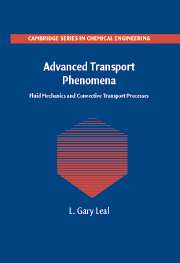Book contents
- Frontmatter
- Contents
- Preface
- Acknowledgments
- 1 A Preview
- 2 Basic Principles
- 3 Unidirectional and One-Dimensional Flow and Heat Transfer Problems
- 4 An Introduction to Asymptotic Approximations
- 5 The Thin-Gap Approximation – Lubrication Problems
- 6 The Thin-Gap Approximation – Films with a Free Surface
- 7 Creeping Flow – Two-Dimensional and Axisymmetric Problems
- 8 Creeping Flow – Three-Dimensional Problems
- 9 Convection Effects in Low-Reynolds-Number Flows
- 10 Laminar Boundary-Layer Theory
- 11 Heat and Mass Transfer at Large Reynolds Number
- 12 Hydrodynamic Stability
- Appendix A Governing Equations and Vector Operations in Cartesian, Cylindrical, and Spherical Coordinate Systems
- Appendix B Cartesian Component Notation
- Index
7 - Creeping Flow – Two-Dimensional and Axisymmetric Problems
Published online by Cambridge University Press: 05 June 2012
- Frontmatter
- Contents
- Preface
- Acknowledgments
- 1 A Preview
- 2 Basic Principles
- 3 Unidirectional and One-Dimensional Flow and Heat Transfer Problems
- 4 An Introduction to Asymptotic Approximations
- 5 The Thin-Gap Approximation – Lubrication Problems
- 6 The Thin-Gap Approximation – Films with a Free Surface
- 7 Creeping Flow – Two-Dimensional and Axisymmetric Problems
- 8 Creeping Flow – Three-Dimensional Problems
- 9 Convection Effects in Low-Reynolds-Number Flows
- 10 Laminar Boundary-Layer Theory
- 11 Heat and Mass Transfer at Large Reynolds Number
- 12 Hydrodynamic Stability
- Appendix A Governing Equations and Vector Operations in Cartesian, Cylindrical, and Spherical Coordinate Systems
- Appendix B Cartesian Component Notation
- Index
Summary
In the preceding chapters, a number of asymptotic methods were introduced for the approximate solution of nonlinear flow problems. In many of the cases considered so far, including all of the problems of the two preceding chapters, the asymptotic limiting process produced a simplification of the full nonlinear problem by restricting the geometry of the flow domain to one in which certain terms in the equations could be neglected because the length scales in some direction (or directions) become very large compared with the length scales in other directions. In retrospect, even the exact unidirectional flow problems of Chap. 3 can often be regarded as a first approximation of some more general problem in which the geometry reduces to a unidirectional form in the limit as a ratio of two length scales vanishes, e.g., the “Dean” problem of Chap. 4, which reduces to the unidirectional Poiseuille flow problem in the limit as the ratio of the tube radius to the radius of curvature of the tube in the axial direction goes to zero. In some cases, this disparate ratio of length scales was true everywhere in the flow domain, and then the asymptotic solution was found to be “regular”; e.g., the Dean problem or the eccentric cylinder problem of Chap. 5. In others, the region with a small length-scale ratio was restricted to a local part of the overall flow domain, and in these cases, the asymptotic approximation was of the “singular” type, in which the simplified form of the governing equations is valid only locally, and the resulting approximate solution must be “matched” to a solution of the unapproximated equations that are valid elsewhere.
- Type
- Chapter
- Information
- Advanced Transport PhenomenaFluid Mechanics and Convective Transport Processes, pp. 429 - 523Publisher: Cambridge University PressPrint publication year: 2007



